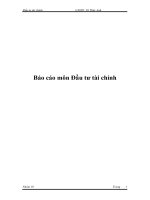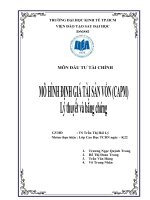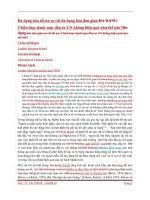Thuyết trình môn đầu tư tài chính mô hình index
Bạn đang xem bản rút gọn của tài liệu. Xem và tải ngay bản đầy đủ của tài liệu tại đây (2.12 MB, 60 trang )
CHAPTER EIGHT
INDEX MODELS
University of Economics, Ho Chi Minh City - UEH
Slide Team
•
•
•
•
Trần Thị Thanh Thủy
Phạm Thanh Nhất
Võ Thị TrúcXuân
Huỳnh Thị Bé Tư
Giảng viên hướng dẫn: TS Trần Thị Hải Lý
8.1 A SINGEL FACTOR SECURITY MARKET
Drawbacks of Markowitz model
1. The Input List of the Markowitz Model:
- The estimates of expected security returns.
- The covariance matrix
EX:
n = 50 estimates of expected returns
n = 50 estimates of variances
(n2 - n)/2 = 1,225 estimates of covariances
estimates
1,325 total
Drawbacks of Markowitz model
If n = 100 , we need 5,150 estimates
n = 300, we need 4,5 million estimates
This work is very hard.
2. Errors in the assessment or estimation of correlation coefficients can lead
to nonsensical results
EX:
Standard
Asset
Deviation (%)
A
20
B
20
C
20
A
B
C
1.00
0.90
0.90
0.90
1.00
0.00
0.90
0.00
1.00
Drawbacks of Markowitz model
EX:
- Suppose that you construct a portfolio with weights: -1.00; 1.00;
1.00, for assets A; B; C, respectively, and calculate the portfolio
variance.
- You will find that the portfolio variance appears to be negative (200). This of course is not possible because portfolio variances cannot
be negative.
Drawbacks of Markowitz model
This chapter we introduce index models that simplify estimation of the
covariance matrix and greatly enhance the analysis of security risk
premiums.
Normality of Returns and Systematic Risk
- The rate of return on any security, i, into the sum of its expected plus
unanticipated components:
ri = E (ri) + ei
+ E (ri) : expected return
+ ei
: unexpected return
ei, has a mean of zero and a standard deviation of бii that measures the
uncertainty about the security return.
Normality of Returns and Systematic Risk
- Joint normally distributed: security returns are driven by one common
variables
- Multivariate normal distribution: When more than one variable drives
normally distributed security returns
Normality of Returns and Systematic Risk
ri = E (ri) + m + ei
+ m: The macroeconomic factor, measures unanticipated macro
surprises.
(mean =0, бm )
+ ei : measures only the firm-specific surprise
+ m and ei are uncorrelated
Normality of Returns and Systematic Risk
- The variance of ri :
бi2 = бm2 + б2 (ei )
- The covariance between any two securities i and j:
Cov (ri, rj) = cov (m + ei, m + ej) = бm2
- We can capture this refinement by assigning each firm a sensitivity coefficient to macro
conditions, βi
8.2 THE SINGLE INDEX MODEL
•-
The Regression Equation of the Single-Index Model
The market index :
M
Excess return:
RM = rM – rf
Standard deviation:
The regression equation is:
Ri(t) =
-
(8.8)
The intercept: i
The slope coefficient:
The Expected Return-Beta Relationship
-•
-
E(Ri) =
(8.9)
The part of a security’s risk premium is due to the risk premium of the index.
Systematic
risk premium: E(RM)
Nonmarket premium:
Risk and Covariance in the Single-Index Model
- Total risk = Systematic risk + Firm-specific risk
- Covariance = Product of betas
•
x
Market index risk
Cov(ri, rj) =
- Correlation = Product of correlations with the market index
Corr(ri, rj) = = = Corr(ri, rM) x Corr(rj, rM)
The Set of Estimates Needed for the Single-Index Model
•
•
•
•
•
n estimates of the extra-market expected excess returns,
n estimates of the sensitivity coefficients, i
n estimates of the firm-specific variances, 2(e i)
1 estimate for the market risk premium,
E(R M)
1 estimate for the variance of the (common) macroeconomic factor,
M
The Index Model and Diversification
- The excess rate of return on each security is given by:
Ri =
- The excess return on the portfolio of stocks as:
•
Rp =
The part of the portfolio risk attributable to nonmarket factors becomes ever smaller.
•
Wi = 1/n
8.3 Estimating the Single-Index Model
Base on the single-index mode, we provide an extended example that begins with estimation of the regression equation and
continues through to the estimation of the full covariance matrix of security returns .
R
( t)
= α i + β i RM
i
Focus on only six large U.S. corporations:
* Hewlett-Packard and Dell from the information technology
( t)
+ ei ( t )
(IT) sector of the S&P 500
* Target and Walmart from the retailing sector
* British Petroleum and Royal Dutch Shell from the energy sector
Work with monthly observations of rates of return for the six stocks, the S&P 500 portfolio, and T-bills over a 5-year period
(60 observations)
The Security Characteristic Line for
Hewlett Packard
The index model regression Equation restated for Hewlett Packard (HP) is
.
(t) = +(t)+ (t)
The regression estimates describe a straight line with intercept and slope which we call the security
characteristic line (SCL) for HP
The Security Characteristic Line for
Hewlett Packard
The annualized standard deviation of the excess return on the S&P 500 portfolio over the period was 13.58%, while that of HP
was 38.17%. The swings in HP’s excess returns suggest a greater-than average sensitivity to the index, that is, a beta greater
than 1.0
The Security Characteristic Line for
Hewlett Packard
- The regression line is drawn through the scatter.
- Scatter diagram shows monthly swings of over 630% for HP, but returns in the range of 211% to 8.5% for the S&P 500
The Explanatory Power of the SCL for HP
- The correlation of HP with the S&P 500 is quite high (.7238)
- The R-square (.5239) tells us that variation in the S&P 500 excess returns explains about 52% of the variation in the HP series
- Correlation between regression forecasts and realizations of out-of-sample data is almost always considerably lower than in-sample
correlation.
Analysis of Variance
- If you divide the total SS of the regression (.7162) by 59, you will obtain the estimate of the variance of the dependent variable (HP), .
012 per month, equivalent to a monthly standard deviation of 11%
- The R-square equals SS divided by the total SS









